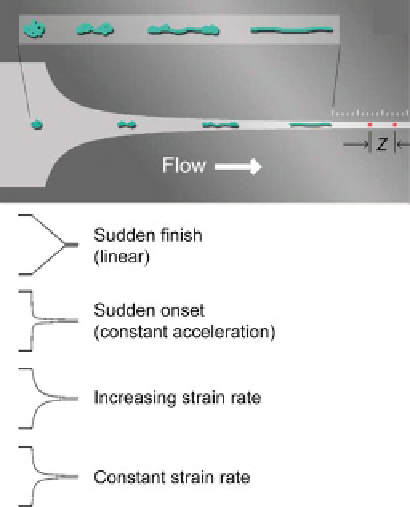Biomedical Engineering Reference
In-Depth Information
Fig. 7.21
Funneled
microfluidic channels for
DNA stretching. Four
different funnel shapes were
designed to examine the
influence of the strain rate
profile on DNA stretching
(Reproduced from Ref. [
93
]
with permission of The Royal
Society of Chemistry)
By modifying the glass surface with positively charged silane, DNA molecules
can be attached onto the surfaces via electrostatic interactions firmly. Schwartz
and coworkers utilized this property and further combined a capillary action into
the system which renders individual DNA molecules to be elongated along the
direction of capillary flow [
95
]. The critical capillary action was produced by
straight PDMS microfluidic channels (with width of
100
m)
made by standard soft lithography (Fig.
7.22
a). The attached DNA molecules were
cleaved in situ by sequence-specific restriction endonuclease and stained with the
fluorescent dye. The ends of DNA recoil, leaving gaps that can be seen under a
microscope (Fig.
7.22
b). They developed custom software to analyze the massive
micrographs data and produce ordered restriction maps from single molecules of
DNA, which includes identifying the cleaved DNA fragments, estimating their
sizes, and ordering collinear fragments [
96
]. Preservation of physical ordering of
the fragments obviated the need for complex reassembly of map information (this
step was highly skilled and time-consuming), and the use of long DNA molecules
greatly reduced the complexity of the analyzed sample.
In addition to the measurements above that provide the relative size (starting from
one end of molecule) of DNA in unit “base,” microfluidic devices can also output
the absolute size in standard units of length. Sizing DNA accurately at the level of
single molecules is increasingly important to genome analysis as well as to predict
diseases at molecular level. Usually the diameter of the DNA double helix is 2 nm
(i.e., known as B-form DNA), and there is a complete helical turn every 3.4 nm, with
approximately 10.5 bp per turn [
97
]. However, native DNA molecules always curled
m and depth of 8

Search WWH ::

Custom Search